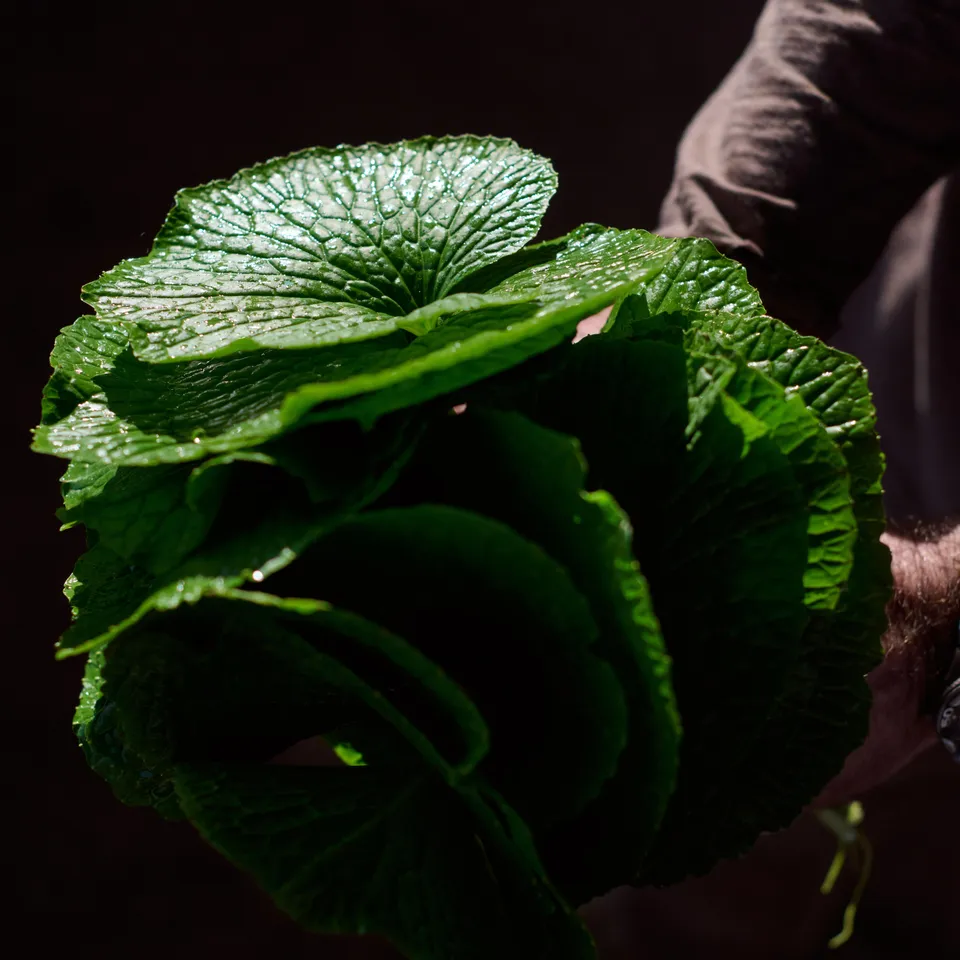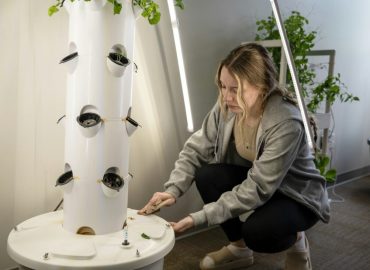Growing Wasabi
Only 10 Places Outside Japan Grow Wasabi. Israel Is One of Them
It takes two years to cultivate, the price is sky-high, and the flavor is best for just a short time. Now, some fanatic devotees in Israel are trying to cultivate locally grown wasabi
Growing Wasabi | Ronit Vered |
The car belonging to the security officer at Eliad, a community in the southern Golan Heights, slowly passes by the greenhouse. Anyone who grew up on a moshav or kibbutz is all too familiar with the look on the driver’s face – the one that says, “Who are you and what are you doing here?” An inquiring look that takes its time studying unfamiliar cars and faces.
“It’s a look that prompts a phone call to check on what is happening and who these visitors are,” says an amused Ran Ronen, who built the greenhouse himself. Inside it, he cultivates wasabi, an essential ingredient in Japanese cuisine that has become an expensive raw material in global markets.
The local farm where it’s grown – complete with its dusty greenhouse sheeting and the disorderly lean-to alongside it – is as different as it could be from the wasabi farms of Japan, where the plants and their beautiful white flowers grow amid gurgling streams flowing down from mountain summits.
But his greenhouse in the Golan Heights is one of only about 10 places outside Japan where the sought-after plant is grown commercially.
Ronen, born in 1982, moved to the Golan with his family six years ago. “We were accepted to Eliad’s agricultural association, and then we had to think about what to do with the land [we had] in Nahala. I don’t come from an agriculture background. Over my years in central Israel, I worked in other fields, mainly solar energy. Wasabi is really my first agricultural project.”
Currently, the three most widely grown crops in the southern Golan are grapes for wineries, almonds and olives. There are also citrus groves and a few orchards of deciduous trees (apples and other fruits), but it’s hard to find field crops and greenhouses in the communities of the southern Golan.
“I wanted to try to think out of the box,” says Ronen. “In terms of the weather, it is an intensely cold winter here, and a dry climate. This means that it’s possible to cool greenhouses relatively easily. If you raise the humidity inside the greenhouse, you will manage to lower the temperature, and that is the principle on which the farmers of the Arava Desert rely.
“Even when it is 45 degrees [Celsius] outside, they manage to cool the temperature in the greenhouse by 15 degrees or more, because of the dryness. A friend of mine who had tasted real wasabi from Japan said that I should look into it, and I started reading and researching these plants online, and became obsessed with it.”
Small farmers who try to survive in a world of industrial agriculture and global markets frequently adopt premium crops with a unique consumer niche.
One of the first things Ronen discovered about wasabi was that it is difficult to find research in the West about the Japanese plant, either because of the cultural tendency of residents of the Japanese islands to keep to themselves, or because of purely economic considerations.
Despite the international popularity of Japanese cuisine in recent decades – there is hardly a single country in the world that does not now have restaurants that specialize in sushi – Japanese farmers continued to to be the exclusive growers, and thus the sole exporters, of wasabi.
We all supposedly consume wasabi at local Japanese restaurants, but it is almost always an imitation – a blend of horseradish, wasabi powder and food coloring – as opposed to the natural, greenish puree of the real plant.
Wild wasabi grows on Japanese mountain summits at an altitude of 750-900 meters, and in clean and oxygen-rich water from streams created by melted snow. The large, beautiful leaves, which are heart-shaped and edible, develop beneath the foliage of tall forest trees.
The plant, a member of the Brassicaceae family, is often called “Japanese horseradish” in the West, due to the similarity of flavor and aroma, which is released only when grating either the European garden horseradish root or the rootstalk of fresh wasabi (while we have grown accustomed to calling it a root, botanically speaking, it is a rootstalk that sends tendrils upward and roots downward).
Wasabi’s pungency (its “heat”) is milder than horseradish, and it is also somewhat sweeא. The flavors and aromas are best for only a short while after being grated in slow, circular movements into a green paste with the use of a unique grater (made from sharkskin in Japanese tradition). In traditional Japanese cuisine, wasabi routinely accompanies raw fish to add to the flavor, but also out of a belief that it helps the body digest the raw flesh.
“When the Japanese domesticated the plant, they continued to grow it in water,” says Ronen. “The most highly desired, and most expensive, wasabi is still grown along the banks of streams on plots of land that are nearly inaccessible. In other places, it is grown with a sort of terraced system where water flows from one terrace down to the next.
“We had to crack the technique for growing it here, because we don’t have flowing streams – we’re talking about hundreds of thousands of cubic meters – and you have to bring the water to a temperature of between 12 and 15 degrees, which is the temperature at which the plant flourishes. It doesn’t really make sense in Israel. Even in countries that have a lot of flowing stream water, they don’t always manage to figure out the method. Wasabi is now grown outside of Japan in only a few places – a few farms in the U.S. in California and Oregon, a farm in Tasmania, a farm in British Columbia, and in two places in Europe.”
Ronen was not the first Israeli farmer to attempt to grow wasabi. Around a decade ago, there was an attempt by the Central Mountain Region Agricultural Research and Development Center (the agricultural R&D center for some areas of the West Bank) to acclimate and grow the plant.
“I discovered that there were [wasabi] plants in Israel,” says Ronen. I brought them to the Golan, and they died within a month. I sat down, learned from it and decided that I would nevertheless try to figure it out, and now I am again bringing plants from Japan– a process that takes about a year until you get the necessary permits. But a moment before I sent in the application, in order to ascertain that I was not completely crazy, I consulted with Nir Rubin.”

Rubin is the man responsible for the niche crops of the kibbutz of Merom Golan. “I have been engaged in this field for nearly two decades, and I really believe in it,” he says. “The idea is to invest in a product where the profit potential is great, because very few people are successful at growing it, or to exploit the local conditions and our agricultural capability in order to bring high-quality crops to the market off-season. In Merom Golan, for example, we have in the past few years been growing broccoli and strawberries in the summer.”
With Rubin’s “approval” –“He didn’t fall over himself about it or give an unequivocal answer, but he did say that I had not completely lost my mind, and that there was a certain logic to my lunacy,” Ronen says –, Ronen ordered new plants from Japan. A year after beginning the bureaucratic process, new wasabi tissue cultures arrived in the country.
“They are cared for the same way you would care for young mammals,” he says. “In order to acclimate laboratory plants, that are clean and nurtured by a sugar solution, to local conditions and convert them into seedlings, you need at least four months.
“It was then that we built this greenhouse – my wife and I enlisted friends who helped – and a logistics system that we thought would be able to withstand the mission. And then we realized that it wasn’t working. It took us a lot of time and a lot of attempts until we succeeded in creating an agricultural protocol that allows us to grow high-quality wasabi in Israel.”
The farmers and entrepreneurs refuse to reveal the exact method, but the plants are not grown in the local greenhouse with the technique in which they are constantly immersed in water, but rather on a separate substrate that resembles pebbles, and with irrigation that makes it possible to deliver regular and frequent amounts of water. The quantity of water that the crop consumes is still greater than that of others, but according to the farmers, once production increases, water consumption will drop.

A year ago, two years after Rubin began to professionally supervise Ronen, Merom Golan became a partner in the initiative. “From the start, it was clear to me and to Ran that the altitude of Merom Golan, about 1,000 meters above sea level, was closer to the original conditions than that of the greenhouse in Eliad, at 350 meters,” says Rubin. “The new greenhouse that was built in Merom Golan has already been prepared and water-recycling systems have already been built in. If yields increase, water recycling will become economically viable.”
The high cost of wasabi is not only a result of low supply and high demand, but also of its lengthy growing period. The rootstalk (also known as the rhizome), which is the most sought-after part of the plant, all of which are edible, develops only after two years.
“It is long and complicated farming,” says Ronen. “In Japan, which has a quality-classification system based on parameters such as growing region, cultivar, and age, the price of wasabi is between 750 and 950 shekels per kilo; and in Europe, where practically none is grown and which depends on imports from Japan, the price is 1,200 to 1,300 shekels. The domestic market is very important to us, but it is small and limited, and of course we are looking to export.”
In the past year, fresh wasabi rootstalks produced locally have been shipped – as well as wasabi leaves and flowers – to leading restaurants in Israel, among them Turkiz, Taizu and Shila in Tel Aviv, Pescado in Ashdod, and others. Marketing to restaurants and private consumers is conducted by Aleh Aleh, a company owned by Yuval Helman and Gideon Belinski.

“It is an expensive product, and its market penetration journey will be a lengthy one,” says Belinski. “But I want to provide a rich toolbox to chefs and to cooks, professional or home-based, whether we are talking about chubeza (mallow) and chicory, or whether it is wasabi or daikon. In Israel, it is not common to find the forbearance that Ronen and Rubin are displaying.”
“The fact that they’ve managed to grow wasabi in Israel is a significant accomplishment,” says Meidan Siboni, considered one of the most respected sushi chefs in Israel. In the past year, Siboni has been using locally produced fresh wasabi in the private dinners he prepares. “The fresh root is almost always preferable to the substitutes – powder or even excellent-quality preserved puree imported from Japan – but the product still doesn’t have uniform quality.
“The texture, flavor and color don’t always manage to reach those of the Japanese raw material. But these things take time. I also thought after six or seven years of preparing sushi that I knew everything, and a single trip to Japan taught me humility.”
The post Growing Wasabi appeared first on GROZINE.



